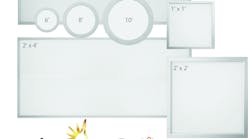EFB technology, in which thin films are bonded on dissimilar materials, allows driver ICs to be integrated with LEDs. Oki Printing Solutions has used this technique to develop unique LED arrays for LED printheads that are already in use on the C3400 high-speed and compact color LED printer.
In conventional LED printheads, LED array chips and integrated circuit (IC) driver chips are mounted on a printed circuit board and are connected by bonding wires. However, high-density wire bonding and large bonding pads limit the density of LED arrays and printing resolutions.
Using EFB technology, AlGaAs-based LED chip arrays are bonded with silicon IC wafers by utilizing intermolecular bonding forces. This allows production of higher-density devices with lower power consumption.
Oki Group also made efforts in shrinking the size of driver IC chips and LED array chips, reducing the density of bonding wires, and reducing the number of chips. The EFB technology also leads to reduced fabrication cost and material cost.
"Epi Film Bonding is a promising technology for the integration of dissimilar materials," said Mikihiko Maeno, President and CEO of Oki Data Corporation. "The volume of the new 600dpi LED printhead is half of that of the conventional LED printheads, and will be equipped in our color and monochrome LED printers that are planned for shipment. By developing this technology further, Oki Printing Solutions plans to develop ultra small printheads of 1200dpi or more to enable higher resolution printing."
Oki Electric, on the other hand, will continue to research this technology to provide smaller, lower power consumption and lower cost semiconductor ICs as well as super-small LED displays.
Toshiba uses surface features to boost LED brightness
Toshiba has developed a surface-processing technology that can significantly enhance the brightness of LEDs, according to an article on Nikkei net (subscription required).
Toshiba's approach is to add nanometer-sized protrusions to the surface of the LED enhance light extraction.
The first step of the process is to coat the surface with liquid glass and then bake it until it is hard. The next step is to coat the glass surface with a polymer made by linking polystyrene and polymethylmethacrylate.
When this polymer coating is heated to around 200 °C, the polystyrene forms spheres. Using plasma, the polymethylmethacrylate is removed, leaving a surface spotted with polystyrene. Masking this pattern and using plasma to etch away the glass and semiconductor substrate leaves a rough surface with protrusions standing 450-500nm tall and spaced 150-200nm apart.
According to Toshiba, this procedure based on molecular self-organization is cheaper than using lithography to treat the surface. Toshiba has used the technology on red LEDs and believes it can also be used to boost the brightness of white LEDs.






